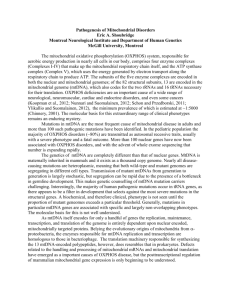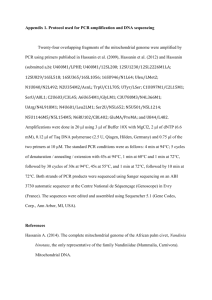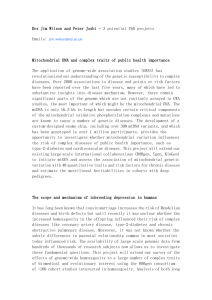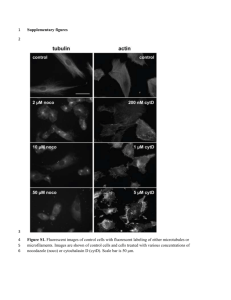Mitochondrial DNA Mutations and Disease
advertisement
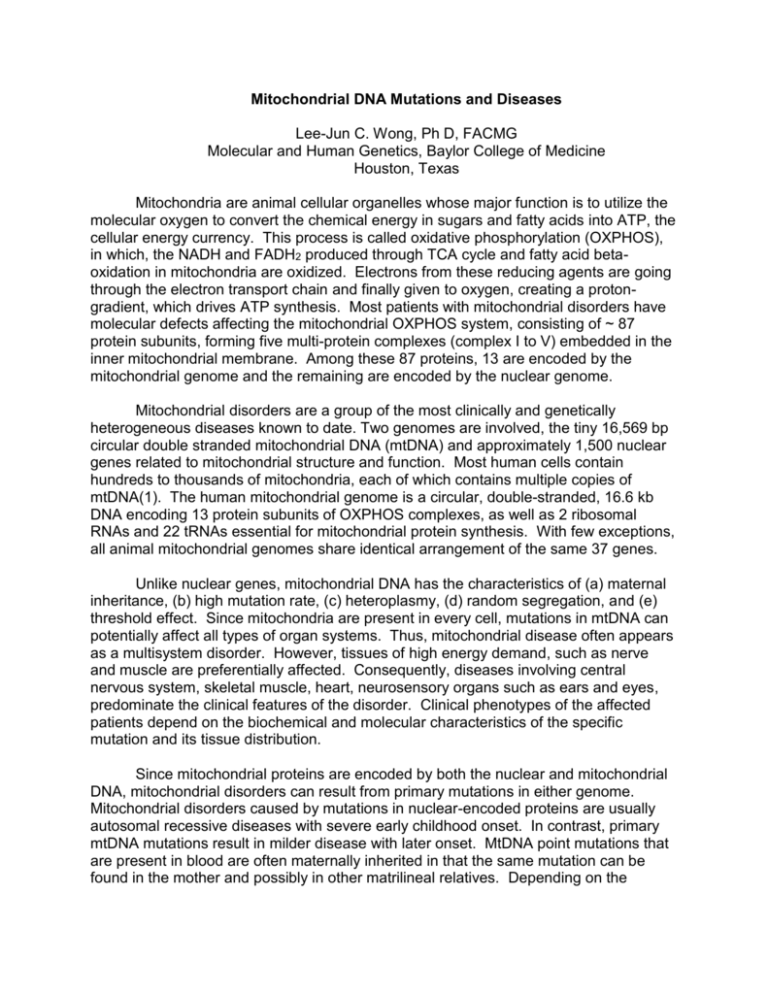
Mitochondrial DNA Mutations and Diseases Lee-Jun C. Wong, Ph D, FACMG Molecular and Human Genetics, Baylor College of Medicine Houston, Texas Mitochondria are animal cellular organelles whose major function is to utilize the molecular oxygen to convert the chemical energy in sugars and fatty acids into ATP, the cellular energy currency. This process is called oxidative phosphorylation (OXPHOS), in which, the NADH and FADH2 produced through TCA cycle and fatty acid betaoxidation in mitochondria are oxidized. Electrons from these reducing agents are going through the electron transport chain and finally given to oxygen, creating a protongradient, which drives ATP synthesis. Most patients with mitochondrial disorders have molecular defects affecting the mitochondrial OXPHOS system, consisting of ~ 87 protein subunits, forming five multi-protein complexes (complex I to V) embedded in the inner mitochondrial membrane. Among these 87 proteins, 13 are encoded by the mitochondrial genome and the remaining are encoded by the nuclear genome. Mitochondrial disorders are a group of the most clinically and genetically heterogeneous diseases known to date. Two genomes are involved, the tiny 16,569 bp circular double stranded mitochondrial DNA (mtDNA) and approximately 1,500 nuclear genes related to mitochondrial structure and function. Most human cells contain hundreds to thousands of mitochondria, each of which contains multiple copies of mtDNA(1). The human mitochondrial genome is a circular, double-stranded, 16.6 kb DNA encoding 13 protein subunits of OXPHOS complexes, as well as 2 ribosomal RNAs and 22 tRNAs essential for mitochondrial protein synthesis. With few exceptions, all animal mitochondrial genomes share identical arrangement of the same 37 genes. Unlike nuclear genes, mitochondrial DNA has the characteristics of (a) maternal inheritance, (b) high mutation rate, (c) heteroplasmy, (d) random segregation, and (e) threshold effect. Since mitochondria are present in every cell, mutations in mtDNA can potentially affect all types of organ systems. Thus, mitochondrial disease often appears as a multisystem disorder. However, tissues of high energy demand, such as nerve and muscle are preferentially affected. Consequently, diseases involving central nervous system, skeletal muscle, heart, neurosensory organs such as ears and eyes, predominate the clinical features of the disorder. Clinical phenotypes of the affected patients depend on the biochemical and molecular characteristics of the specific mutation and its tissue distribution. Since mitochondrial proteins are encoded by both the nuclear and mitochondrial DNA, mitochondrial disorders can result from primary mutations in either genome. Mitochondrial disorders caused by mutations in nuclear-encoded proteins are usually autosomal recessive diseases with severe early childhood onset. In contrast, primary mtDNA mutations result in milder disease with later onset. MtDNA point mutations that are present in blood are often maternally inherited in that the same mutation can be found in the mother and possibly in other matrilineal relatives. Depending on the degree of mutation heteroplasmy and its tissue distribution, clinical phenotype varies. Somatic/sporadic mtDNA mutations may occur in any tissue. For example, some cases with mitochondrial myopathy and exercise intolerance may have mtDNA mutations in muscle only. Therefore, the absence of mtDNA mutations in blood sample does not always rule out the diagnosis of mitochondrial DNA disorders. There are some common mtDNA point mutations and deletions with classical, recognizable syndromes, including MELAS, MERRF, NARP, Leigh disease, LHON, Pearson syndrome and Kearnes Sayre syndrome. Mitochondrial myopathy due to mtDNA multiple deletions may be secondary to primary mutations in nuclear genes responsible for the maintenance of mtDNA integrity. In addition to qualitative changes in mtDNA, there are quantitative changes in mtDNA copy number, known as mtDNA depletion or mtDNA over-amplification. The over-amplification of mtDNA is usually a compensatory mechanism for reduced mitochondrial function, while mtDNA depletion is caused by genetic defects in one of a group of nuclear genes involving mtDNA biosynthesis, which is usually a severe autosomal recessive disorder with early onset and poor prognosis. Mitochondrial disorders similar to human have been reported in animals. This includes mitochondrial myopathy in a German Shepherd dog, Alaskan Husky encephalopathy (Leigh syndrome), and sensory ataxic neuropathy in Golden Retriever dogs. Diagnosis of human mitochondrial disorders is challenging due to the clinical and genetic heterogeneity. Even the analysis of the small 16.6 kb mitochondrial genome is a great challenge. In general, comprehensive analyses involve the application of multiple different methodologies including Sanger sequencing for the detection of point mutations, ARMS qPCR for quantification of heteroplasmy, and array comparative genome hybridization or PCR/sequencing to determine deletion breakpoints. These procedures are tedious. Recently, the clinical application of next generation deep sequencing technology resolves these hurdles in one-step. Conclusions Mutations in mitochondrial DNA cause a broad spectrum of diseases with the major clinical features involving muscle and nerve. Tissue distribution and the degree of mtDNA mutation heteroplasmy determine the clinical phenotype. Mitochondrial myopathy may be caused by mtDNA point mutations and large deletions, which may be secondary to nuclear gene defects. The novel next generation sequencing technology provides a comprehensive clinical molecular diagnostic approach to mtDNA disorders. Selected reading 1. Smeitink J, van den Heuvel L, DiMauro S. 2001. The genetics and pathology of oxidative phosphorylation. Nat Rev Genet 2: 342-52 2. Baranowska I et al. 2009. Sensory ataxic neuropathy in golden retriever dogs is caused by a deletionin the mitochondrial tRNAtyr gene. PLoS Genet 5:e1000499 3. Paciello O, et al. 2003. Mitochondrial myopathy in a German Shepherd dog. Vet Pathol 40:507-511
